Citywide Metro-to-Bus Transfer Behavior Identification Based on Combined Data from Smart Cards and GPS
Abstract
:1. Introduction
- Estimate the missing boarding stations for each ground-level bus passenger by integrating bus SC and GPS data, where the system only records the boarding time;
- Develop a new method with station-specific elapsed time threshold estimation to extract actual metro-to-bus interchange trips; and
- Use the dynamic threshold to measure the level of service for metro-to-bus transfer stations, and discover the transfer points with poor connectivity in an urban public transportation network.
2. Literature Review
3. Data Collection and Analysis
3.1. Data Source
3.2. Data Analysis
- Scenario 1: different time period on the same day of the weekdays (6:00–23:00 on 11–15 March) on March 2019.
- Scenario 2: weekdays (11–15 March, Monday to Friday) vs. weekends (16–17 March, Saturday to Sunday);
- Scenario 3: festivals (February 19 was China Lantern Festival, and March 8 was Women’s Day) vs. weekends (17 March was Sunday).
- The average transfer time and volume per hour are very similar from 7:00 to 21:00 on weekdays. It is consistent with that of Zhao et al. [27], who found that the metro-to-bus transfer is relatively stable throughout the week. However, we also find they significantly fluctuate over different time periods on the same day in Figure 1. Particularly, the difference of average transfer time between 6:00 and 17:00 on 14–15 March is up to 4 min.
- As shown in Figure 1b, a.m. peak hours are from 7:00–9:00 and p.m. peak hours are from 17:00–19:00, based on estimated transfer volume on weekdays. There is a big difference of transfer behavior between weekdays and weekends in Figure 1b. Especially, the transfer volumes during a.m. and p.m. peak hours on weekdays are much larger than on weekends.
- Different from weekends, the transfer passengers waste much more travel time from metro to bus at 14:00 on festival days with a maximal time gap about 2 min greater than on weekends in Figure 2a. Moreover, the transfer volumes between 7:00–16:00 at festivals is much higher than on weekends, and the situation is reversed after 16:00 in Figure 2a.
- The transaction date and time recorded by the smart card system is correct.
- The elapsed time threshold of each station should be different because they have different configurations, i.e., the layout of metro station, traffic facilities, pedestrian walkways, and transfer distance, etc.
- The elapsed time thresholds should vary with the time of day and day of week (e.g., peak hours versus off-peak hours) because the passenger transfer time with different travel purposes is diverse, as shown in Figure 1.
- The elapsed time thresholds should be constant at the same time period at a specific station because the previous average transfer time and volumes are similar, such as peak hours on weekdays in Figure 1.
4. Model Development
4.1. Identification Framework
4.2. Bus Passenger Boarding Station Inference
4.3. Elapsed Time Threshold Determination
4.3.1. First Estimation Based on Rule 1
4.3.2. Second Estimation Based on Rule 2
4.4. Solution Algorithm
5. Case Studies
5.1. Validation with Person Trip Survey Data
5.1.1. Survey Data Collection
5.1.2. Elapsed Time Threshold Estimation with SC and GPS Data
5.1.3. Comparisons and Analysis
- From the U test results, the transfer results obtained by the two recognition methods are not significantly different from the survey data at 7:00–9:00 on 21–22 March and 18:00–20:00 on 23–24 March because all p values are greater than 0.05. In particular, the p value obtained by the developed dynamic model in this paper is improved by 0.04 and 0.23 compared to the traditional static method at 7:00–9:00 on 21–22 March and 18:00–20:00 on 23–24 March, respectively. These improvements indicate that the station-specific transfer recognition in this study has greater accuracy and reliability to capture actual transfer trips than the one-size-fits-all criterion.
- The average transfer trip time of the two recognition methods are a little less than that of the surveyed data. Especially, the estimated average transfer time of four metro stations at 7:00–9:00 on 21–22 March in this study is much smaller than the traditional method because the transfer time thresholds identified in this study are less than 30 min. On the contrary, the means of transfer time in this study at 18:00–20:00 on 23–24 March are greater and the thresholds of the previous method are greater than 30 min. Hence, the dynamic station-specific recognition method can effectively identify the actual interchange behavior of the majority of bus passengers and remove the few transfer trips which have other purposes, such as shopping or business holding near the metro or bus station.
5.2. Identification Performance Analysis
5.3. Application to Citywide Transfer Analysis
- The metro-to-bus walking distance should be no greater than the acceptable threshold.
- Transit agencies should consider opening more transfer bus lines or increase bus frequency at overcrowded metro stations.
- Some narrow corridors connecting metro and bus stations should be changed to one-way roads.
- Convenient crossing facilities such as pedestrian overpasses and underground subways are crucial for high-quality metro-to-bus interchanges.
6. Discussion & Conclusions
Author Contributions
Funding
Acknowledgments
Conflicts of Interest
References
- Nesheli, M.M.; Ceder, A.A. Improved reliability of public transportation using real-time transfer synchronization. Transp. Res. Part C Emerg. Technol. 2015, 60, 525–539. [Google Scholar] [CrossRef]
- Guo, X.; Sun, H.; Wu, J.; Jin, J.; Zhou, J.; Gao, Z. Multiperiod-based timetable optimization for metro transit networks. Transp. Res. Part B Methodol. 2017, 96, 46–67. [Google Scholar] [CrossRef]
- Brons, M.; Givoni, M.; Rietveld, P. Access to railway stations and its potential in increasing rail use. Transp. Res. Part A Policy Pract. 2009, 43, 136–149. [Google Scholar] [CrossRef]
- Seriani, S.; Fernández, R. Planning guidelines for metro–bus interchanges by means of a pedestrian microsimulation model. Transp. Plan. Technol. 2015, 38, 569–583. [Google Scholar] [CrossRef]
- Pronello, C.; Longhi, D.; Gaborieau, J.B. Smart Card Data Mining to Analyze Mobility Patterns in Suburban Areas. Sustainability 2018, 10, 3489. [Google Scholar] [CrossRef]
- Cherry, T.; Townsend, C. Assessment of potential improvements to metro–bus transfers in Bangkok, Thailand. Transp. Res. Rec. J. Transp. Res. Board 2012, 2276, 116–122. [Google Scholar] [CrossRef]
- Navarrete, F.J.; de Dios Ortúzar, J. Subjective valuation of the transit transfer experience: The case of Santiago de Chile. Transp. Policy 2013, 25, 138–147. [Google Scholar] [CrossRef]
- Wang, Z.J.; Chen, F.; Xu, T.K. Interchange between metro and other modes: Access distance and catchment area. J. Urban Plan. Dev. 2016, 142, 04016012. [Google Scholar] [CrossRef]
- Munizaga, M.A.; Palma, C. Estimation of a disaggregate multimodal public transport Origin–Destination matrix from passive smartcard data from Santiago, Chile. Transp. Res. Part C Emerg. Technol. 2012, 24, 9–18. [Google Scholar] [CrossRef]
- Park, J.Y.; Kim, D.J.; Lim, Y. Use of smart card data to define public transit use in Seoul, South Korea. Transp. Res. Rec. J. Transp. Res. Board 2008, 2063, 3–9. [Google Scholar] [CrossRef]
- Munizaga, M.; Devillaine, F.; Navarrete, C.; Silva, D. Validating travel behavior estimated from smartcard data. Transp. Res. Part C Emerg. Technol. 2014, 44, 70–79. [Google Scholar] [CrossRef]
- Trépanier, M.; Habib, K.M.; Morency, C. Are transit users loyal? Revelations from a hazard model based on smart card data. Can. J. Civ. Eng. 2012, 39, 610–618. [Google Scholar] [CrossRef]
- Kusakabe, T.; Iryo, T.; Asakura, Y. Estimation method for railway passengers’ train choice behavior with smart card transaction data. Transportation 2010, 37, 731–749. [Google Scholar] [CrossRef]
- Jánošíková, Ľ.; Slavík, J.; Koháni, M. Estimation of a route choice model for urban public transport using smart card data. Transp. Plan. Technol. 2014, 37, 638–648. [Google Scholar] [CrossRef]
- Ma, X.; Wang, Y. Development of a data-driven platform for transit performance measures using smart card and GPS data. J. Transp. Eng. 2014, 140, 04014063. [Google Scholar] [CrossRef]
- Zhou, J.; Murphy, E.; Long, Y. Commuting efficiency in the Beijing metropolitan area: An exploration combining smartcard and travel survey data. J. Transp. Geogr. 2014, 41, 175–183. [Google Scholar] [CrossRef]
- Okamura, T.; Zhang, J.; Fujiwara, A. Finding behavioral rules of urban public transport passengers by using boarding records of integrated stored fare card system. In Proceedings of the 10th World Conference on Transport Research World Conference on Transport Research Society Istanbul Technical University, Istanbul, Turkey, 4–8 July 2004. [Google Scholar]
- Bagchi, M.; White, P. What role for smart-card data from bus systems? Munic. Eng. 2004, 157, 39–46. [Google Scholar] [CrossRef]
- Bagchi, M.; White, P.R. The potential of public transport smart card data. Transp. Policy 2005, 12, 464–474. [Google Scholar] [CrossRef]
- Seaborn, C.; Attanucci, J.; Wilson, N.H. Analyzing multimodal public transport journeys in London with smart card fare payment data. Transp. Res. Rec. J. Transp. Res. Board 2009, 2121, 55–62. [Google Scholar] [CrossRef]
- Mohamed, K.; Côme, E.; Oukhellou, L.; Verleysen, M. Clustering smart card data for urban mobility analysis. IEEE Trans. Intell. Transp. Syst. 2016, 18, 712–728. [Google Scholar]
- Devillaine, F.; Munizaga, M.; Trépanier, M. Detection of activities of public transport users by analyzing smart card data. Transp. Res. Rec. J. Transp. Res. Board 2012, 2276, 48–55. [Google Scholar] [CrossRef]
- Wang, Z.J.; Liu, Y.; Chen, F. Evaluation and Improvement of the Interchange from Bus to Metro Using Smart Card Data and GIS. J. Urban Plan. Dev. 2018, 144, 05018004. [Google Scholar] [CrossRef]
- Zhao, D.; Wang, W.; Woodburn, A.; Ryerson, M.S. Isolating high-priority metro and feeder bus transfers using smart card data. Transportation 2017, 44, 1535–1554. [Google Scholar] [CrossRef]
- Gordon, J.B.; Koutsopoulos, H.N.; Wilson, N.H.; Attanucci, J.P. Automated inference of linked transit journeys in London using fare-transaction and vehicle location data. Transp. Res. Rec. J. Transp. Res. Board 2013, 2343, 17–24. [Google Scholar] [CrossRef]
- Nassir, N.; Hickman, M.; Ma, Z.L. Activity detection and transfer identification for public transit fare card data. Transportation 2015, 42, 683–705. [Google Scholar] [CrossRef]
- Zhao, D.; Wang, W.; Li, C.; Ji, Y.; Hu, X.; Wang, W. Recognizing metro-bus transfers from smart card data. Transp. Plan. Technol. 2019, 42, 70–83. [Google Scholar] [CrossRef]
- Shenzhen Statistics Department. Shenzhen Statistical Yearbook 2018. Available online: http://tjj.sz.gov.cn/xxgk/zfxxgkml/tjsj/tjnj/201812/P020181229639722485550.pdf (accessed on 29 December 2018).
- Chen, S. Annual Report on the Development of Shenzhen Economy; Social Science Academic Press (China): Beijing, China, 2018; Volume 11. [Google Scholar]
- Shenzhen Shenzhentong, Co.Ltd Shenzhentong Events. Available online: https://www.shenzhentong.com/about/aboutDJS_101009003.html (accessed on 19 January 2018).
- De Oña, J.; Gómez, P.; Mérida-Casermeiro, E. Adjustment boarding and alighting passengers on a bus transit line using qualitative information. Appl. Math. Model. 2014, 38, 1147–1158. [Google Scholar] [CrossRef]
- Gade, K. A non-singular horizontal position representation. J. Navig. 2010, 63, 395–417. [Google Scholar] [CrossRef]
- Limpert, E.; Stahel, W.A.; Abbt, M. Log-normal distributions across the sciences: Keys and clues: On the charms of statistics, and how mechanical models resembling gambling machines offer a link to a handy way to characterize log-normal distributions, which can provide deeper insight into variability and probability—normal or log-normal: That is the question. BioScience 2001, 51, 341–352. [Google Scholar]
- Jang, W. Travel time and transfer analysis using transit smart card data. Transp. Res. Rec. J. Transp. Res. Board 2010, 2144, 142–149. [Google Scholar] [CrossRef]
- Nachar, N. The Mann–Whitney U: A test for assessing whether two independent samples come from the same distribution. Tutor. Quant. Methods Psychol. 2008, 4, 13–20. [Google Scholar] [CrossRef]

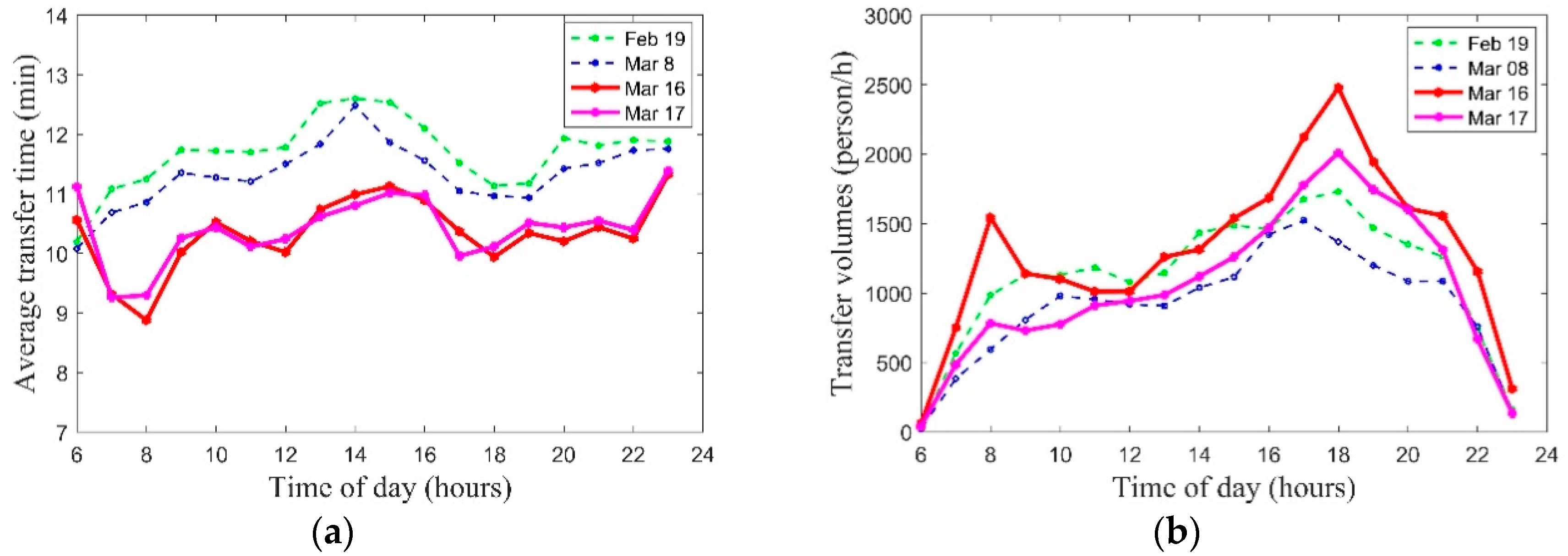
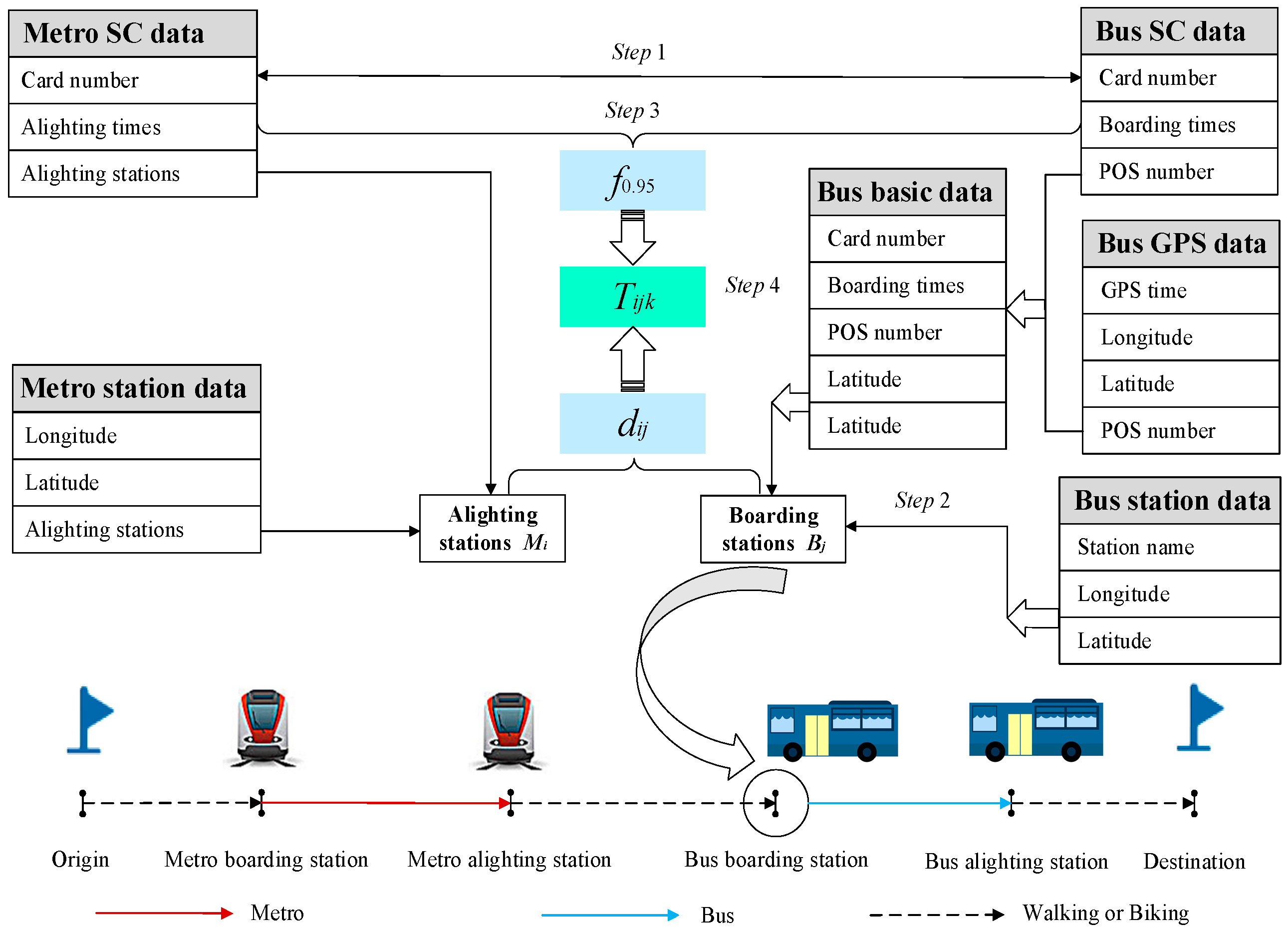
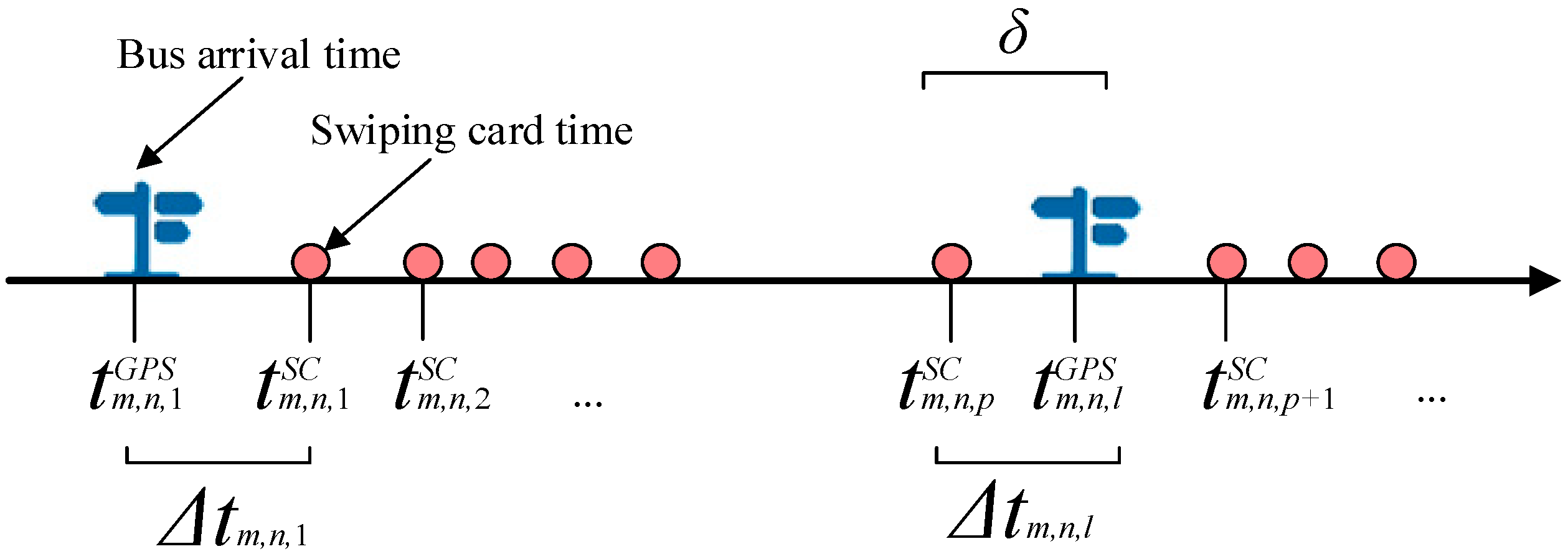
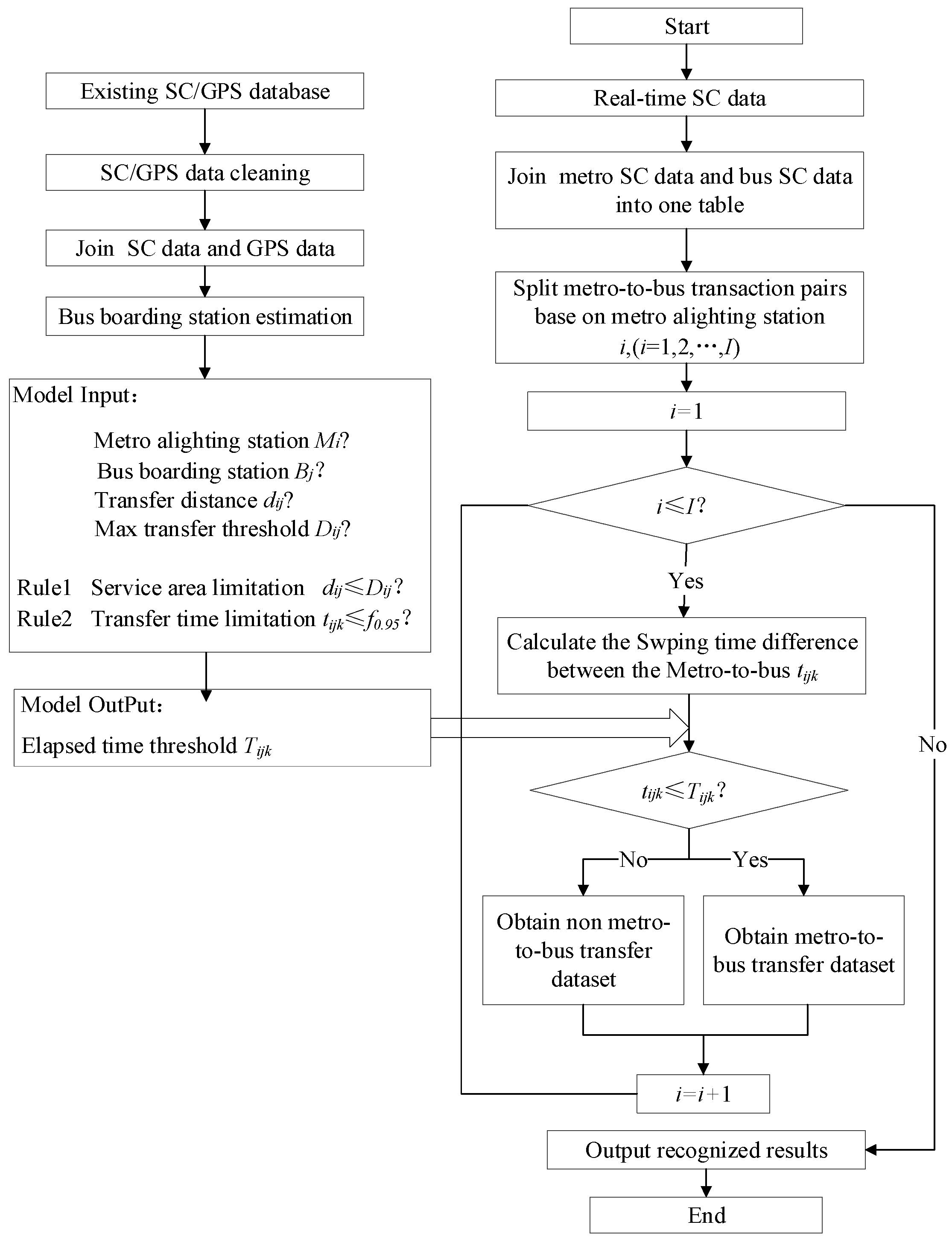


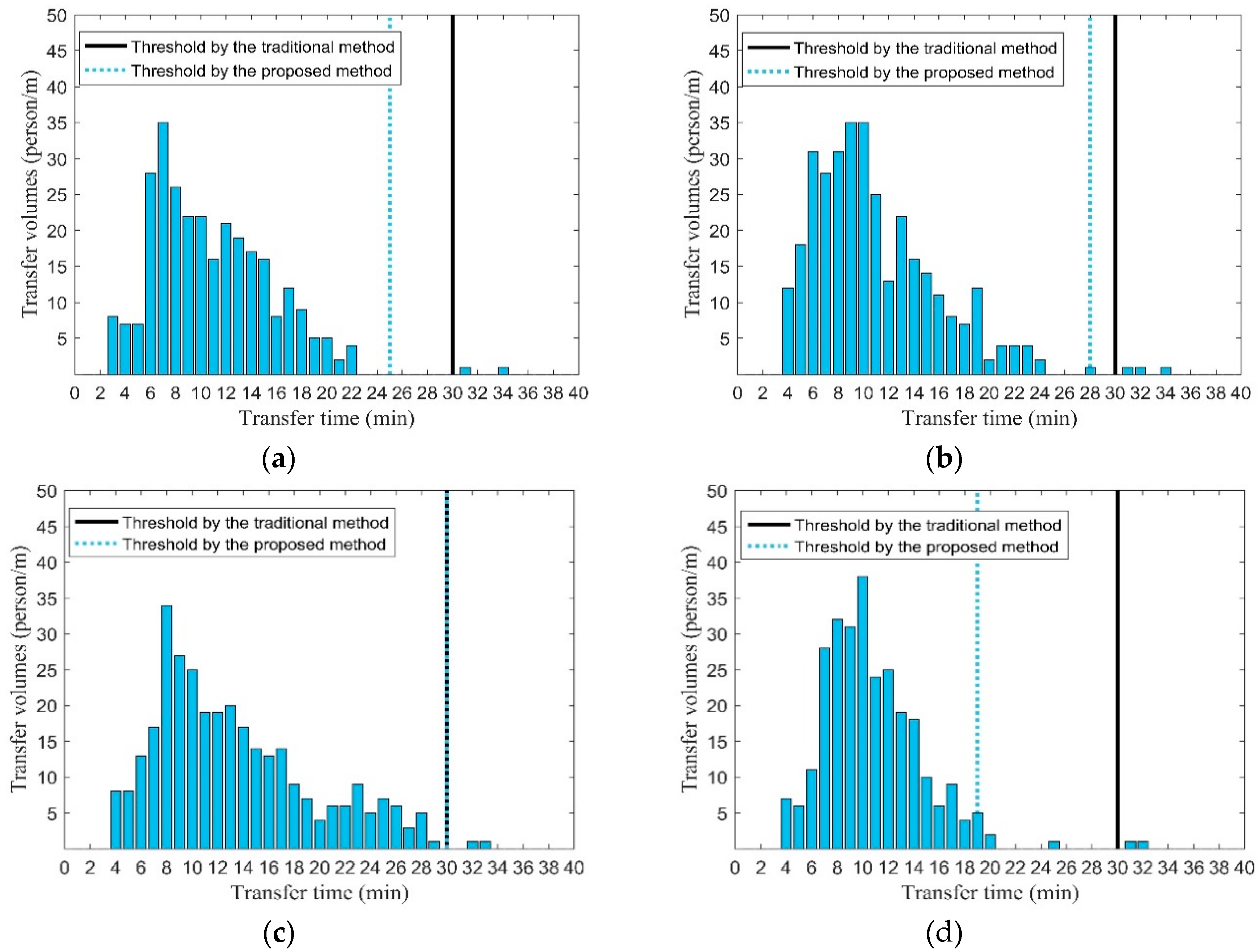
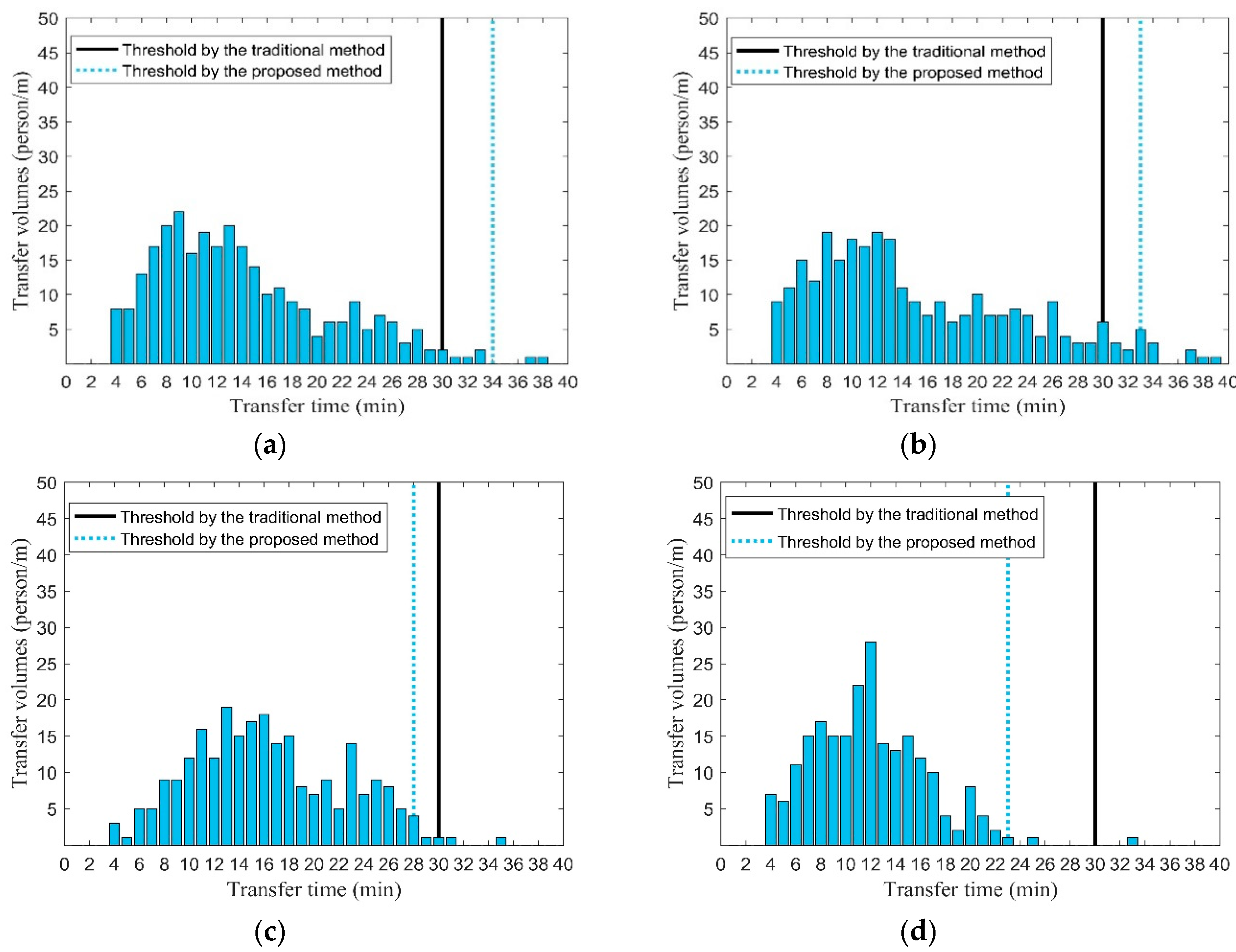
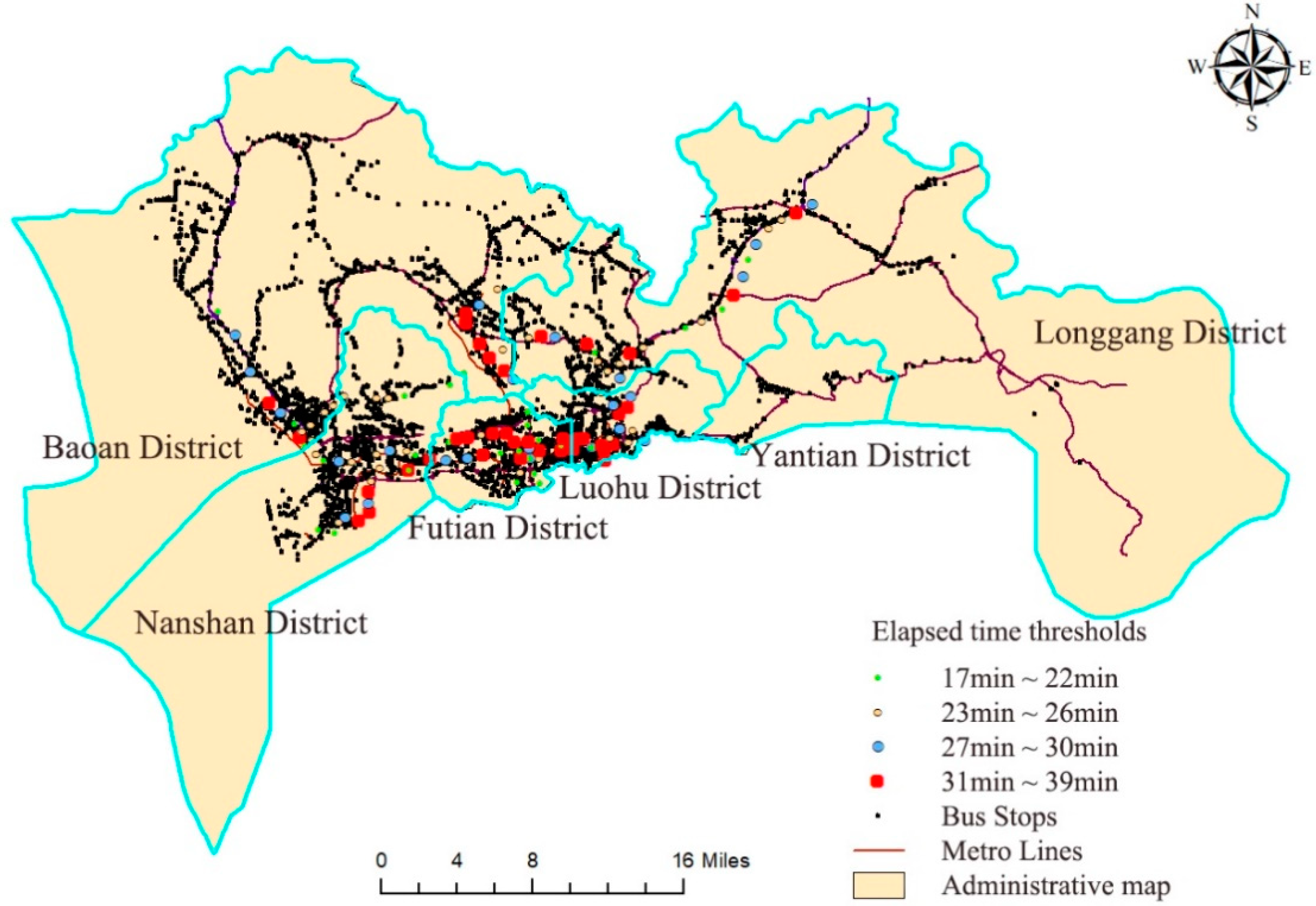
| Scenario | Day of Week | Time Period | Time of Day |
|---|---|---|---|
| S1 | Weekdays | AM-peak hours | 07:00–09:00 |
| S2 | PM-peak hours | 18:00–20:00 | |
| S3 | Off-peak hours | 09:00–18:00 | |
| S4 | Weekends | AM-peak hours | 07:00–09:00 |
| S5 | PM-peak hours | 18:00–20:00 | |
| S6 | Off-peak hours | 09:00–18:00 |
| Stations | Guomao | Shenzhen University | Daxin | Airport East | |
|---|---|---|---|---|---|
| Scenarios | |||||
| 7:00–9:00 on 11–15 March | 25 min | 28 min | 30 min | 19 min | |
| 18:00–20:00 on 16–17 March | 34 min | 33 min | 28 min | 23 min | |
| Stations | Guomao | Shenzhen University | Daxin | Airport East | |||||||||
|---|---|---|---|---|---|---|---|---|---|---|---|---|---|
| Survey Data | Static Model | Dynamic Model | Survey Data | Static Model | Dynamic Model | Survey Data | Static Model | Dynamic Model | Survey Data | Static Model | Dynamic Model | ||
| 7:00–9:00, 21–22 March | Volumes | 291 | 1464 | 1448 | 338 | 1549 | 1538 | 318 | 1528 | 1528 | 278 | 1032 | 1026 |
| Average | 10.87 | 10.54 | 10.49 | 11.03 | 9.11 | 8.96 | 13.31 | 10.09 | 10.09 | 10.76 | 8.78 | 8.66 | |
| Variance | 22.14 | 19.84 | 18.52 | 25.85 | 25.49 | 22.64 | 38.47 | 29.17 | 29.17 | 15.63 | 12.78 | 10.29 | |
| U test | - | 0.27 | 0.28 | - | 0.25 | 0.26 | - | 0.18 | 0.18 | - | 0.17 | 0.19 | |
| 18:00–20:00, 23–24 March | Volumes | 290 | 857 | 875 | 287 | 823 | 838 | 250 | 858 | 851 | 223 | 792 | 784 |
| Average | 14.17 | 10.25 | 10.56 | 15.76 | 10.52 | 10.92 | 16.27 | 11.43 | 11.28 | 12.03 | 8.72 | 8.31 | |
| Variance | 48.57 | 33.14 | 39.68 | 65.21 | 32.22 | 40.15 | 37.35 | 31.08 | 31.01 | 21.94 | 33.22 | 25.53 | |
| U test | - | 0.16 | 0.29 | - | 0.17 | 0.27 | - | 0.16 | 0.17 | - | 0.19 | 0.18 | |
| Stations | S1 | S2 | S3 | S4 | S5 | S6 | |
|---|---|---|---|---|---|---|---|
| Scenarios | |||||||
| Guomao | 25 min | 22 min | 30 min | 22 min | 34 min | 33 min | |
| Shenzhen University | 28 min | 29 min | 35 min | 25 min | 33 min | 35 min | |
| Daxin | 30 min | 29 min | 35 min | 30 min | 28 min | 33 min | |
| Airport East | 19 min | 18 min | 26 min | 18 min | 23 min | 29 min | |
| Stations | S1 | S2 | S3 | S4 | S5 | S6 | |||||||
|---|---|---|---|---|---|---|---|---|---|---|---|---|---|
| Scenarios | Static Model | Dynamic Model | Static Model | Dynamic Model | Static Model | Dynamic Model | Static Model | Dynamic Model | Static Model | Dynamic Model | Static Model | Dynamic Model | |
| Guomao | 927 | 899 | 217 | 210 | 341 | 341 | 182 | 174 | 142 | 143 | 393 | 406 | |
| Shenzhen University | 907 | 897 | 419 | 418 | 611 | 646 | 345 | 341 | 300 | 306 | 871 | 908 | |
| Daxin | 1098 | 1098 | 917 | 917 | 642 | 666 | 420 | 420 | 409 | 406 | 806 | 827 | |
| Airport East | 766 | 753 | 745 | 730 | 701 | 698 | 336 | 329 | 443 | 433 | 944 | 940 | |
© 2019 by the authors. Licensee MDPI, Basel, Switzerland. This article is an open access article distributed under the terms and conditions of the Creative Commons Attribution (CC BY) license (http://creativecommons.org/licenses/by/4.0/).
Share and Cite
Huang, Z.; Xu, L.; Lin, Y.; Wu, P.; Feng, B. Citywide Metro-to-Bus Transfer Behavior Identification Based on Combined Data from Smart Cards and GPS. Appl. Sci. 2019, 9, 3597. https://doi.org/10.3390/app9173597
Huang Z, Xu L, Lin Y, Wu P, Feng B. Citywide Metro-to-Bus Transfer Behavior Identification Based on Combined Data from Smart Cards and GPS. Applied Sciences. 2019; 9(17):3597. https://doi.org/10.3390/app9173597
Chicago/Turabian StyleHuang, Zilin, Lunhui Xu, Yongjie Lin, Pan Wu, and Bin Feng. 2019. "Citywide Metro-to-Bus Transfer Behavior Identification Based on Combined Data from Smart Cards and GPS" Applied Sciences 9, no. 17: 3597. https://doi.org/10.3390/app9173597
APA StyleHuang, Z., Xu, L., Lin, Y., Wu, P., & Feng, B. (2019). Citywide Metro-to-Bus Transfer Behavior Identification Based on Combined Data from Smart Cards and GPS. Applied Sciences, 9(17), 3597. https://doi.org/10.3390/app9173597





